This week on T3, I’m reviewing a new company in the Talent space called Workshape. Workshape is a new technology that is attempting to change the way we describe human work, and that is no small feat.
Think about all the changes we’ve seen in recruiting and HR over the past 50 years. What one thing is still constant, and probably shouldn’t be? The resume! That little piece of paper almost all organizations still rely on to understand what someone’s background is, and what they might be able to bring to your organization.
Workshape’s technology describes work without using text-based documents. Workshape describes work using times and tasks. In a major way, Workshape has uncovered a great way for your organization to ensure an organizational fit between a candidate and a hiring manager’s expectations for a position.
Workshape works by both the candidate and hiring manager using a super-simple interface to tell each other what they want from the position. A candidate might want to spend 50% of their time in front-end development and only 10% of their time in testing when in reality the hiring manager is looking for the exact opposite. This is what Workshape does, without the candidate knowing, so they don’t try and ‘cheat’ the system.
The candidate will give you a great, realistic overview of how they would prefer to spend their time in a position. Workshape’s technology then gives you a spider diagram that shows you how the candidate and the position match or don’t match.
5 Things I really like about Workshape
- Ultimately, this technology could be a great tool to help companies hire better for fit, not to the organization, but to positions. For some companies, this is a huge issue, that Workshape could solve.
- I love the fact that this technology doesn’t allow candidates to tell you what you want to hear. It forces the candidate to tell you what they really want, and ultimately, that might give you great data on whether they would be a great fit or not, for your opening.
- The user interface that the hiring manager uses to choose what they want from the position, literally, takes seconds to use, and it’s super easy and engaging for hiring managers.
- The results of the match give you a range on closest match, so even if someone isn’t perfect, you can easily see where they didn’t match and make a determination how important that is or isn’t.
- You get to find out from candidates what they want to do, and not to do. I can foresee this technology being used for internal mobility as well to match for succession.
Workshape is currently set up as an open market place so anyone can use it and try it. Currently, their focus on technology in three major metro areas: San Fran, New York and London, from a candidate pool standpoint. But, like I mentioned above, the technology has much more of market, eventually, from a fit standpoint within your own hiring process.
Definitely worth a look, and a try if you’re in that market. If you would prefer to look at how you could implement into your own hiring process for fit to position, reach out to them, I’m sure they would have interest in speaking about that as well.
T3 – Talent Tech Tuesday – is a weekly series here at The Project to educate and inform everyone who stops by on a daily/weekly basis on some great recruiting and sourcing technologies that are on the market. None of the companies who I highlight are paying me for this promotion. There are so many really cool things going on in the space and I wanted to educate myself and share what I find. If you want to be on T3 – send me a note.

Hey Megan,
Thanks for your comment!
We absolutely see the need to move into our job categories and other industry segments. We feel that most jobs can be considered as ‘time-over-tasks’ and consequently could be Workshaped. We’re debating what the next vertical should be – do you have any thoughts for us here?
Thank you for sharing this Tim. Hung- this platform is incredibly ahead of the curve and forward thinking for recruitment needs. Tim’s 5th point is what I find most appealing. The hiring manager gets to the core of what the candidate does not want to spend their time doing or enjoy. While I see the immediate need for this in the technology sector do you foresee building this out for other industries?
Thanks for this write up Tim. Hope your readers enjoy reading it as much as I did. Happy to answer any questions via comments here